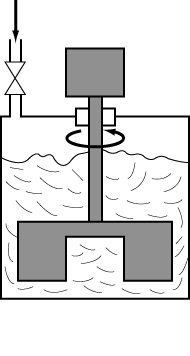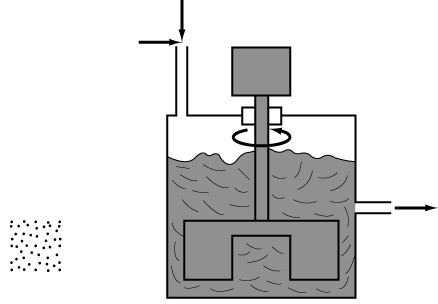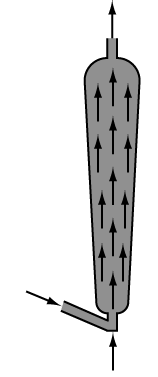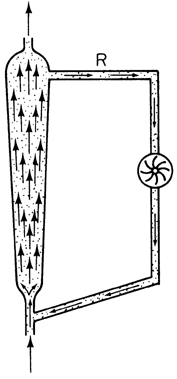
Figure 5-14
Integral reactor.
|
The successful design of industrial reactors lies primarily with the reliability of the experimentally determined parameters used in the scale-up. Consequently, it is imperative to design equipment and experiments that will generate accurate and meaningful data. Unfortunately, there is usually no single comprehensive laboratory reactor that could be used for all types of reactions and catalysts. In this section we discuss the various types of reactors that can be chosen to obtain the kinetic parameters for a specific reaction system. We shall closely follow the excellent strategy presented in the article by V. W. Weekman of Mobil Oil.7 The criteria used to evaluate various types of laboratory reactors are listed in Table 5-3. |
|
TABLE 5-3. |
| 1. Ease of sampling and product analysis |
| 2. Degree of isothermality |
| 3. Effectiveness of contact between catalyst and reactant |
| 4. Handling of catalyst decay |
| 5. Reactor cost and ease of construction |
| In a stirred-batch reactor the catalyst is dispersed as a slurry, as shown in Text Figure 5-15. Although this reactor has better contact between the catalyst and fluid than either the differential or integral reactors, it has a sampling problem. Samples of fluid are usually passed through cyclones or withdrawn through filters or screens to separate the catalyst and fluid, thereby stopping the reaction. However, slow quenching of the reaction in the cyclone or plugging of the filter sampling system by the catalyst particles is a constant concern, thus making the rating in the sampling category only fair. Since the system is well mixed, its isothermality is good. There is good contact between the catalysts and reactants, and the contact time is known since the catalyst and reactants are fed at the same time. However, if the catalyst decays, the activity and selectivity will vary during the course of data collection. | |

Figure 5-15 |
| Although there are a number of designs for contained-solids reactors, all are essentially equivalent in terms of performance. A typical design is shown in Text Figure 5-16. In this reactor, catalyst particles are contained in paddles that rotate at sufficiently high speeds to minimize external mass transfer effects (see Chapter 11) and, at the same time, keep the fluid contents well mixed. With this type of operation, isothermal conditions can be maintained and there is good contact between the catalyst and fluid. If the catalyst particle size is small, difficulties could be encountered containing the particles in the paddle screens. Consequently, it receives only a fair rating in the ease of construction and cost category. Although this type of reactor receives a good rating for ease of sampling and analysis of product composition, like the three previous reactors, it suffers from being unable to generate useful data when the catalyst being studied decays. As a result, it receives a poor rating in the catalyst decay category. | |
|
Minimizes |
Figure 5-16 |
| In this reactor (Figure 5-17), fresh catalyst is fed to the reactor along with the fluid feed and the catalyst leaves the reactor in the product stream at the same rate that it is fed. As a result, the catalyst in the reactor is at the same level of catalytic activity at all times. Thus we are not faced with the problem encountered in the four previous reactors, in which the kinetic parameters evaluated at the beginning of the experiment will be different than those at the end. However, since there will be a distribution of time that the catalyst particles have been in the reactor, there will be a distribution of catalytic activities of the particles in the bed. The mean activity of a catalyst with first-order decay is derived in Example 14-3. If the mean residence time is large, selectivity disguise could be a problem. Since the reactor is well-mixed, isothermality and fluid--solid contact categories are rated as good. However, difficulties can arise in feeding the slurry accurately and, as with the stirred-batch reactor, it is difficult to quench the reaction products. Consequently, it receives only fair ratings in the first (sampling) and fifth (construction) categories. | |
|
One of the best reactors for isothermal operation |

Figure 5-17 |
| Commercially, the transport reactor (Text Figure 5-18) is used widely in the production of gasoline from heavier petroleum fractions (see Text Figure 1-13). In addition, it has found use in grain drying operations. In this reactor, either an inert gas or the reactant itself transports the catalyst through the reactor. With this reactor, any possibility of catalyst decay/selectivity disguise is virtually eliminated because the catalyst and reactants are fed continuously. For highly endothermic or exothermic reactions, isothermal operation will be difficult to achieve and it receives a poor-to-fair rating in this category. At moderate or low gas velocities there may be slip between the catalyst particles and the gas so that the gas-catalyst contact time will not be known very accurately. Consequently, this reactor receives only a fair-to-good rating in the gas-catalyst contacting category. This reactor is somewhat easier to construct than the CSTR, but salt or sand baths may be required to try to maintain isothermal operation, and it therefore receives a fair-to-good rating in the construction category. Difficulty in separating the catalyst and reactant gas or in thermally quenching the reaction results in a fair rating in the sampling category. | |
|
Best for catalyst decay |

Straight-through transport reactor. [From V. Weekman, AIChE J., 20, 833 (1974). With permission of the AIChE. Copyright © 1974 AIChE. All rights reserved.] |
| By recirculating the gas and catalyst through the transport reactor (Text Figure 5-19 ), a well-mixed condition can be achieved provided that the recirculation rate is large with respect to the feed rate. Consequently, isothermal operation is achieved. Since the reactor is operated at steady state, the kinetic parameters measured at the start of the experiment will be the same as those measured at the end. However, since fresh catalyst is mixed with decayed catalyst from the recycle, the product distribution and the kinetic parameters might not be the same as those measured in a straight-through transport reactor where the gas "sees" only fresh catalyst. The incorporation of a recirculation system adds a degree of complexity to the construction, which gives it a lower rating in this category as well. |
| The ratings of the various reactors are summarized in Table 5-4 in the text. From this table note that the CSTR and recirculating transport reactor appear to be the best choices because they are satisfactory in every category except for construction.8 However, if the catalyst under study does not decay, the stirred batch and contained solids reactors appear to be the best choices. If the system is not limited by internal diffusion in the catalyst pellet, larger pellets could be used and the stirred-contained solids is the best choice. If the catalyst is non-decaying and heat effects are negligible, the fixed-bed (integral) reactor would be the top choice, owing to its ease of construction and operation. However, in practice, usually more than one reactor type is used in determining the reaction rate law parameters. | |

Figure 5-19 |